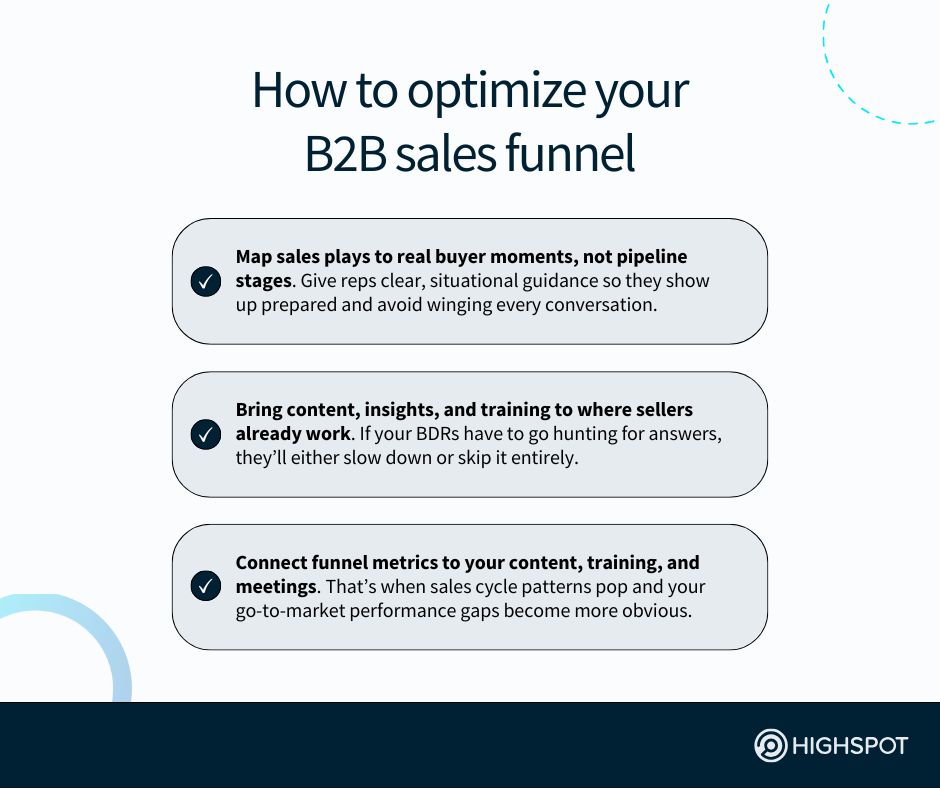Key Takeaways
- To improve sales outcomes, go-to-market (GTM) teams must regularly revisit your B2B sales funnel to adapt your selling strategy in response to changing buyer behaviours and evolving engagement signals.
- Ongoing B2B sales funnel optimisation, when executed with AI-powered GTM tools, helps BDRs better engage prospective customers at every sales cycle stage with personalised content, guidance, and next-best actions and, in turn, improves their odds of converting into new business.
- Routine analysis of sales activities, messaging, content performance, and play adoption is the only way GTM teams can reliably increase conversions and scale revenue growth in a predictable, repeatable way.
The B2B sales funnel has changed (a lot). A few years ago, sales reps could predict every step of a deal. Now, the funnel feels more like a maze than a map.
Your prospects do their own vendor and solution research, discuss options with peers, and contact companies of interest only when they’re close to a decision. That shift makes it harder for sellers to know when and how to step in.
But all is not lost.
A simple recalibration of what the modern sales funnel now looks like (read: the path potential buyers take today to make a purchase) can bring clarity back to your BDRs and empower your entire sales team to improve lead quality, speed up decision-making processes, and close deals faster and more efficiently.
The 8×8 enablement team shares how it revamped its sales funnel content to boost engagement and conversions across every stage of the buyer journey.
What is the B2B sales funnel?
The B2B sales funnel represents every step prospective customers take in their buying process: from initially learning about a business, to becoming loyal customers. Sales teams use it to understand how potential customers discover companies like theirs, evaluate possible solutions, and decide when to buy.
The B2B sales funnel also helps sales teams spot buying clues, focus on qualified leads, and use enablement content that fits every stage of the customer journey to address leads’ distinct needs. An effective funnel brings order to chaos and connects sellers with the right account stakeholders at the right time.

How today’s B2B sales funnel differs from the traditional customer journey for buyers
The old sales funnel was simple. Guided by sellers who held most of the information, potential buyers moved neatly from the awareness stage to the purchase stage, and on a fairly predictable timeline. Simply put, that’s no longer true.
The modern customer journey is different:
- Potential clients conduct extensive reviews into organisations with which they consider signing on with, loop back with BDRs and account executives, skip sales cycle steps altogether, and make decisions at their own pace.
- Some potential buyers come in ready to talk, knowing exactly what they want. Others spend weeks (or months) researching before they ever engage a rep.
- Teams accustomed to linear sales funnels, in which leads who match their buyer persona take the traditional actions of reaching out to brands to formally kick off deal discussions, often struggle with this shift in the customer journey.
Without a clear view of buyer intent, deals can stall or disappear altogether.
Highspot’s GTM Performance Gap Report found that even the most successful go-to-market teams struggle with visibility across complex buyer journeys. However, they’re increasingly embracing AI for sales, marketing, and enablement use cases to rectify this issue.
“High-performing teams aren’t just adopting AI,” per the report. “They’re building the systems that make it work. They align around a shared definition of success, embed enablement across the funnel, and ensure performance signals are visible in real-time.”
The B2B sales funnel stages
Unlike the old days, buyers drive the modern sales process. Instead of asking, “What should I do next?” sales teams must ask, “What does the buyer need right now?” and apply it to the modern sales funnel, which consists of the following key stages.
Awareness stage
Curiosity begins in the awareness stage of the B2B buying journey.
Potential clients start looking for solutions to a problem or pain point, even if they don’t know exactly what they need just yet. They search online, attend product-centric webinars, and read recent articles and reports about their challenges.
The goal in the awareness stage is to educate, not sell.
Sales and marketing teams should share useful insights through webinars, blog content, and posts on social media channels. Potential customers tend to only trust companies that offer unique content and perspectives. Many buyers shy away from marketing content that is either too generic or overly promotional.
The best way to attract potential buyers, increase brand awareness, generate leads, and advance ‘warm’ prospects is to be clear, consistent, and genuine.
Sales and marketing alignment is vital. When content speaks to buyer pain points, prospects move from curiosity to genuine interest. And conversion rates grow.
Interest stage
Potential customers who consistently engage with a company move into the interest stage.
They might subscribe to a newsletter, download a resource, or follow your company on social media. These small but meaningful actions show strong intent and a willingness to progress through the B2B sales funnel.
Put plainly, the interest stage is where effective lead management becomes essential.
To identify active leads and what topics the target audience cares about, teams should track engagement data, website visits, and content downloads.
Consideration stage
Unlike the awareness or interest stage, the consideration stage is when potential buyers begin evaluating possible solutions. They want to know about a company’s unique value proposition and how an offering compares with others.
Your sales team should recognise these needs early and share relevant content that convinces prospects to move along the buying process.
Content that answers specific questions for the target audience is best.
Collateral that helps buyers project ROI, learn about integration ease, or see examples of industry use cases that are similar to theirs are optimal assets to deliver to prospects.
If a lead is comparing automation tools, share a sell sheet that offers a direct comparison between your organisation’s offerings and those of close competitors.
That level of specificity helps potential customers better visualise value.
Evaluation stage
The evaluation stage is when potential customers dig deep. Here, they ask detailed questions, request sales demonstrations, and expect proof a solution works.
Your organisation should use this stage of the B2B sales funnel to build trust.
Instead of mimicking messaging from your marketing campaigns, members of your sales team must focus on a given prospect’s unique goals and challenges. Notably, they should provide tailored demos that reflect real customer environments.
Modern sales models and sales methodologies use data-driven insights to guide these personalised interactions. And AI tools make this easier.
As SaaS exec Eric Anderson wrote for The AI Journal, “Whether streamlining a buyer’s POV, crafting the perfect demo storyline, or acting as a liaison between buyer to seller, AI now serves as an interactive support system across the SaaS pipeline.”
Too many sellers still rely on canned demos. Customising even one slide or example to reflect a particular prospect’s business can double engagement.
What’s more, using an AI-enabled, agentic go-to-market platform like Highspot can help you and your reps surface relevant content, anticipate buyer objections, and personalise every interaction with leads so each prospect keeps progressing through the buying journey (and you avoid longer sales cycles).
NVIDIA shares how it empowers sellers with SmartPages, Spots, and real-time analytics in Highspot’s agentic platform for GTM teams to deliver the right content at every stage of the sales cycle.
Activation stage
Despite your sellers’ best efforts, sometimes, deals lose momentum. Potential customers go quiet, priorities shift, or new stakeholders join the conversation. The activation stage focuses on restarting progress without adding pressure.
To proactively convert potential customers, sales teams should examine customer engagement data across the sales pipeline. Which accounts were once active but have since gone cold? Which prospect no longer responds to emails or phone calls?
Sellers can then use those clues to time outreach and marketing efforts.
Buyers in this phase of the B2B sales funnel are cautious. They pause not from disinterest, but from uncertainty. So, the job is to lower risk, not raise urgency.
Your marketing and sales teams should offer a fresh insight, updated customer story, or industry data that reignites interest. Personalised videos (think 2-minute Loom explainers) or short recaps of previous calls can bring potential customers back into the conversation and speed up the decision-making process.
The goal of the activation stage is simple: Remind prospects what attracted them to your company in the first place, and show them why becoming a loyal client of your business can help them realise their desired return on investment.
Purchase stage
In this stage, an active opportunity you’re engaging is finally ready to commit, but your sales team must tread carefully. Potential customers want to know if your company will provide smooth onboarding, fair pricing, and ongoing post-sale support (the latter being a critical element that can improve customer retention).
Too many teams lose deals right before close because they make buying committees take on extra work like chasing down missing details and docs.
To overcome last-minute hesitation and get prospects to sign on the dotted line, you and other GTM leaders must equip your sales team with compelling proof points like implementation timelines, ROI projections, and quotes from satisfied customers. All communication should be clear, quick, and responsive.
Loyalty stage
The real work begins when prospective customers become existing customers.
To build customer loyalty from day one, your customer success managers need to add consistent value via regular check-ins, personalised insights, and proactive support, leveraging data from the client’s customer journey and product utilisation.
To track customer satisfaction trends and client NPS, revenue operations data access is key.
Sales leaders should identify moments when new customers might need more help or extra training. Proactive customer relationship management can mean the difference between retaining and losing business.
The loyalty stage is especially crucial because loyal customers don’t just renew. They also advocate on your organisation’s behalf (read: send you referrals).
Expansion stage
This is your opportunity for upselling or cross-selling. But that doesn’t mean CSMs should just push new products to every client. Rather, they should consider customer’s needs, challenges, and goals to figure out what adds the most value.
When your business earns loyal customers’ trust by helping them achieve their goals, they welcome ideas that make their jobs easier or more efficient.
Lean on insights to spot opportunities to add more value for existing customers. Which products or services complement what they already use? Which target outcomes can they improve with additional capabilities and solutions?
How to effectively move qualified leads through your B2B sales funnel
It’s evident that the modern sales funnel isn’t static. Rather, it’s a fluid, dynamic system that has a lot of moving parts—and requires a great deal of collaboration by your go-to-market teams to increase your sales conversion rate consistently.
Some best practices you should abide by to reduce your sales cycle length and move potential clients from one funnel phase to the next efficiently include:
Personalising outreach to engage your target audience with relevant, timely messaging
Personalisation builds trust. Your target audience likes knowing your company has created something especially for them. Factor in buyer-intent data, industry trends, and account activity to tailor your outreach efforts. If your prospects feel you understand them, they are far more likely to stay engaged and convert.
What’s more, instead of “Just checking in,” try referencing a recent event or trend related to their industry to show you’re attuned to their market.
With the right sales enablement platform, your BDRs can ensure they have the right context before every call. For instance, using Highspot, they could use our Deal Agent to gather deal intelligence into what content, plays, and messaging have resonated most with buying stakeholders for an account.
This data-driven, AI-powered prep—one that only takes minutes to complete—can mean the difference between a generic conversation and a meaningful one.
Aligning marketing funnel content to the buyer’s stage and informational needs
Every potential customer has different questions, depending where they are in the B2B sales funnel. That’s why it’s critical for your sales and marketing teams to align on content and ensure the right message reaches clients at the right time.
As noted, for early stages, focus on education. For mid-funnel buyers, share comparisons and ROI-focused content. For later stages, use validation materials like case studies and proof-of-value reports. When content matches not just the stage but the mindset of the buyer, the funnel keeps flowing instead of clogging up.
Equipping sellers with content that answers objections and accelerates decision-making
Your sales reps lose valuable time when they’re forced to search for the right materials. Putting all enablement content in one place solves those problems.
Highspot’s AI-driven enterprise content management solution helps sellers find what they need instantly. These tools recommend relevant content based on deal context and help sellers overcome objections to move deals forward faster.
Meanwhile, Highspot’s Content Specialist Agent acts as an AI-powered assistant for your GTM teams that surfaces account-relevant assets at the ideal moment to keep deals progressing and prevent your sales process from stalling out.
Using key metrics to identify friction points and optimise conversion at every stage
Leverage data to ID friction points and optimise conversion at every stage. Your B2B sales funnel performance depends on visibility. To see where progress slows, you must be able to track closed-won rates, deal velocity, and buyer engagement.
‘Blended’ data from your enablement platform, CRM, and other GTM tools can reveal where interest fades or content falls fast. That insight helps sales teams adjust outreach, improve messaging, and strengthen every sales funnel stage.
Of course, optimisation isn’t something your sales and marketing teams should treat as a one-time endeavour. Instead, they must approach it as a perpetual process that keeps your prospects responsive as their behaviour evolves.
Empowering sales managers to coach consistently based on pipeline and behaviour signals
Sales coaching turns insight into action. When managers can see what’s happening across the sales pipeline—which deals are moving, where engagement stalls, and how reps respond—they can coach in real time instead of after the fact.
Highspot’s AI sales coaching software analyses call data and behaviour patterns to uncover what top performers do differently. Managers can use those insights to guide every rep toward more impactful conversations and better deal execution.
Consistent coaching keeps performance steady and helps teams hit revenue goals faster.
Reinforcing value post-sale to drive customer retention, loyalty, and expansion opps
The buyer’s journey obviously doesn’t end with a signature. Keeping paying customers engaged after the sale builds loyalty and opens doors for CLV growth.
Post-sale enablement must focus on proving value early and often. Share performance updates, results achieved, and new ways clients can use your product.
Consider Highspot customer NRG Energy. The energy and home services company uses the sales intelligence generated in our GTM enablement solution to determine which customer accounts are ideal candidates for expansion.
“We determine a customer’s expectation through analytics,” NRG Energy Business Transformation, GTM Strategy leader Lamar Lee III explained. “Being able to bring in insights for cross-sell opportunities and upsell opportunities allows us to drive value and seamless customer support.”
Using an AI-driven approach to optimise your B2B sales funnel
Artificial intelligence is now the ultimate competitive differentiator. Why? Because it’s proven to help GTM teams across industries provide stellar customer experiences and turn interested prospects into paying customers at scale.
“Across the full scope of go-to-market efforts, AI is changing the game,” according to Highspot’s State of Sales Enablement Report 2025.
“It’s empowering organisations to engage buyers better, win more often, and secure greater revenue than ever before,” the report continued. “Simply put, it’s enabling go-to-market teams to execute more effectively and, in doing so, secure unprecedented growth.”
If the emerging tech has yet to be incorporated into your day-to-day go-to-market operations, now’s the time to onboard AI-powered sales tools that can elevate your team’s output and address GTM performance gaps.




